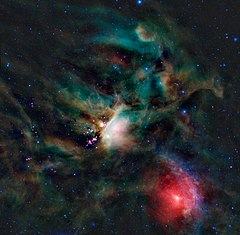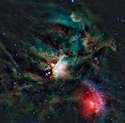Sigma Scorpii
| σ Sco | |||||||||||||||||||||
 Czerwony obszar u dołu zdjęcia to mgławica refleksyjna otaczająca sigmę Scorpii | |||||||||||||||||||||
| Dane obserwacyjne (J2000) | |||||||||||||||||||||
| Gwiazdozbiór | |||||||||||||||||||||
|---|---|---|---|---|---|---|---|---|---|---|---|---|---|---|---|---|---|---|---|---|---|
| Rektascensja | 16h 21m 11,316s[1] | ||||||||||||||||||||
| Deklinacja | -25° 35′ 34,05″[1] | ||||||||||||||||||||
| Paralaksa (π) | |||||||||||||||||||||
| Odległość | |||||||||||||||||||||
| Wielkość obserwowana | |||||||||||||||||||||
| Ruch własny (RA) | -11,42 ± 0,78 mas/rok | ||||||||||||||||||||
| Ruch własny (DEC) | -26,83 ± 0,74 mas/rok | ||||||||||||||||||||
| Prędkość radialna | -7,4 ± 1,3 km/s | ||||||||||||||||||||
| Charakterystyka fizyczna | |||||||||||||||||||||
| Typ widmowy | O9,5 V / B7 V[1] | ||||||||||||||||||||
| Charakterystyka orbitalna | |||||||||||||||||||||
| Okres orbitalny | 33 d[2] | ||||||||||||||||||||
| Alternatywne oznaczenia | |||||||||||||||||||||
| |||||||||||||||||||||
Sigma Scorpii (σ Sco) – gwiazda wielokrotna w gwiazdozbiorze Skorpiona. Znajduje się około 697 lat świetlnych od Słońca.
Nazwa
Gwiazda ma tradycyjną nazwę Alniyat lub Al Niyat, którą dzieliła z Tau Scorpii. Nazwa wywodzi się z języka arabskiego, pochodzi od słowa النياط al niyāţ, oznaczającego „tętnice” (w astronomii arabskiej gwiazda Antares reprezentowała serce)[2][3]. Międzynarodowa Unia Astronomiczna formalnie zatwierdziła użycie nazwy Alniyat dla określenia tej gwiazdy[4].
Charakterystyka
Alniyat należy do asocjacji Skorpiona OB2, grupy podobnych gwiazd powstałych w zbliżonym czasie. W centrum układu znajduje się para bardzo jasnych i gorących gwiazd ciągu głównego, o temperaturze około 30 tysięcy kelwinów i jasnościach od 65 do 27 tysięcy razy większych niż jasność Słońca. Gorętszy składnik należy do późnego typu O, nieco chłodniejszy do typu B. Jest to układ spektroskopowo podwójny, obracający się wokół wspólnego środka masy co 33 dni. Towarzyszą mu dwie słabiej widoczne gwiazdy, również reprezentujące typ widmowy B. Jedna z gwiazd jest zmienną typu Beta Cephei, której jasność zmienia się o 10%. Materia międzygwiazdowa powoduje osłabienie blasku Sigma Scorpii o ponad 1m i sprawia, że wydaje się ona mieć białożółtą, a nie białoniebieską barwę. Promieniowanie tych gwiazd oświetla i jonizuje mgławicę wokół układu, widoczną na zdjęciach astronomicznych. Gwiazdy mają wiek kilku milionów lat; w przyszłości oba składniki centralnej pary eksplodują jako supernowe, podczas gdy ich dalsze towarzyszki zakończą życie jako masywne białe karły[2].
Zobacz też
Przypisy
- ↑ a b c d e Sigma Scorpii w bazie SIMBAD (ang.)
- ↑ a b c Jim Kaler: Sigma Scorpii (ang.). STARS. [dostęp 2016-09-18].
- ↑ Richard Hinckley Allen: Star Names Their Lore and Meaning. Nowy Jork: Dover Publications Inc., 1963, s. 371. ISBN 0-486-21079-0. (ang.)
- ↑ Naming Stars. Międzynarodowa Unia Astronomiczna, 2017-02-01. [dostęp 2017-05-11].
Media użyte na tej stronie
Autor: Szczureq, Licencja: CC BY-SA 4.0
Gwiazdozbiór Skorpiona. Mapa została stworzona przy pomocy programu PP3 autorstwa Torstena Brongera. Wersję wektorową stworzył Szczureq według wzoru z wersji rastrowej, której autorem jest BlueShade.
A rich collection of colourful astronomical objects is revealed in this picturesque image of the Rho Ophiuchi cloud complex from NASA’s Wide-field Infrared Explorer, or WISE. The Rho Ophiuchi cloud (pronounced ‘oh-fee-yoo-ki’ and named after a bright star in the region) is found rising north of the plane of the Milky Way in the night sky, bordering the constellations Ophiuchus and Scorpius. It’s one of the nearest star-forming regions to Earth, allowing us to resolve much more detail than in more distant similar regions, like the Orion nebula.
The amazing variety of different colours seen in this image represents different wavelengths of infrared light. The bright white nebula in the centre of the image (IC 4603) is glowing due to heating from nearby stars, resulting in what is called an emission nebula. The same is true for most of the multi-hued gas prevalent throughout the entire image, including the bluish bow-shaped feature near the bottom right. The bright red area in the bottom right is light from the star in the centre – Sigma Scorpii – that is reflected off of the dust surrounding it, creating what is called a reflection nebula. And the much darker areas scattered throughout the image are pockets of cool dense gas that block out the background light, resulting in absorption (or ‘dark’) nebulae. WISE’s longer wavelength detectors can typically see through dark nebulae, but these are exceptionally opaque.
The bright pink objects just left of centre are young stellar objects (YSOs). These baby stars are just now forming; many of them are still enveloped in their own tiny compact nebulae. In visible light, these YSOs are completely hidden in the dark nebula that surrounds them, which is sometimes referred to as their baby blanket. We can also see some of the oldest stars in our Milky Way Galaxy in this image, found in two separate (and much more distant) globular clusters. The first cluster, M80, is on the far right edge of the image towards the top. The second, NGC 6144, is found close to the bottom edge near the centre. They both appear as small densely compacted groups of blue stars. Globular clusters such as these typically harbour some of the oldest stars known, some as old as 13 billion years, born soon after the Universe formed.
There are two other items of interest in this image as well. At the 3 o’clock position, relative to the bright central region, and about two-thirds of the way from the centre to the edge, there is a small faint red dot. That dot is an entire galaxy far, far away known as PGC 090239. And, at the bottom left of the image, there are two lines emerging from the edge. These were not created by foreground satellites; they are diffraction spikes (optical artefacts from the space telescope) from the bright star Antares that is just out of the field of view.
Position of object (J2000): RA = 16h 25m 17s; Dec = -24° 14’ 49”
Constellation: Ophiucus and Scorpius
Field of View: 1.967x1.948 degrees
The picture covers approximately Declination -22° to -26.1° and Right Ascension 16h17m to 16h37m.
Orientation: North is 0.12966 degrees left of up
Color Mapping: Blue=3.4 microns; Cyan=4.6 microns; Green=12 microns; Red=22 microns

